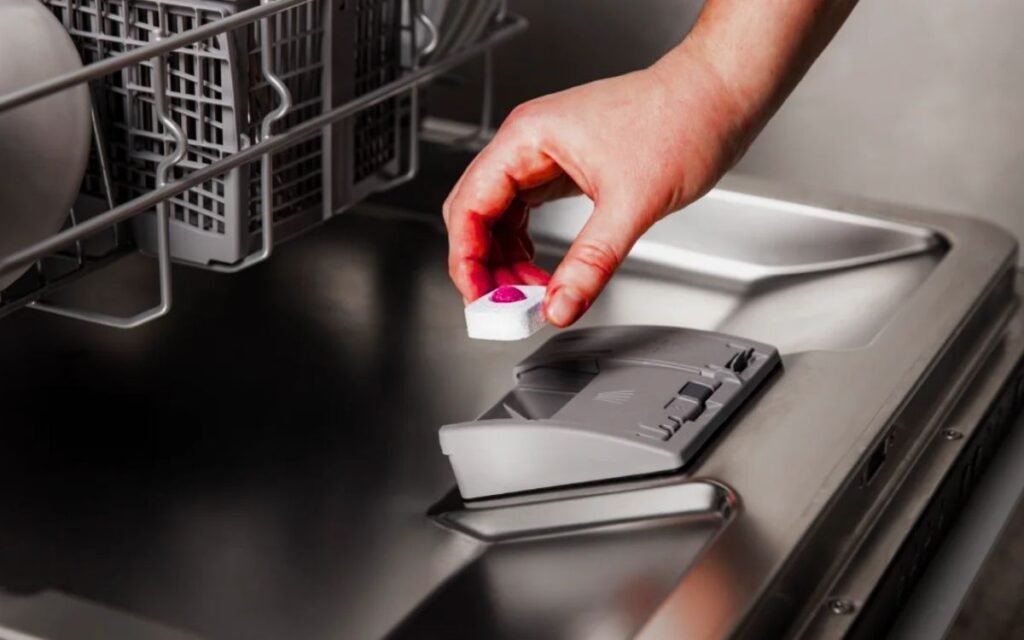You open your dishwasher expecting sparkling clean dishes, only to find a mess of greasy plates, filmy glasses, and worst of all that little block of detergent sitting untouched in its dispenser. It’s a frustratingly common problem, but the good news is, you can often fix it yourself with a little bit of troubleshooting.
At Perfect Appliance Repair, we believe in empowering Australian homeowners to handle what they can and to know when it’s time to call in the experts. This comprehensive guide will walk you through everything—from 5-minute checks to replacing small mechanical parts—to get your dishwasher back in perfect working order.
Before You Touch Anything, Do This
Before you begin any inspection or repair, you must disconnect your dishwasher from power to prevent the risk of electric shock. You can do this in one of two ways:
- Unplug it: If accessible, unplug the dishwasher’s power cord from the wall socket (power point).
- Switch off the Circuit Breaker: Go to your home’s switchboard (fuse box) and flip the circuit breaker that controls your dishwasher to the OFF position.
For any work that involves opening the door panel, it’s also a best practice to turn off the water supply to the dishwasher. The shut-off valve is usually located under the sink.
Common Telltale Signs
If your soap dispenser isn’t opening, you’ll likely notice one or more of these classic symptoms. This guide is for you if:
- The dispenser door is still shut tight after the wash cycle has finished.
- You find a solid, unused detergent pod or tablet in the closed dispenser.
- A partially dissolved, gummy block of powder or gel soap remains.
- Your dishes consistently come out dirty, greasy, or covered in a soapy film.
- The dispenser door latch feels stiff, gummy, or won’t “click” shut properly when you load it.
The Most Common Causes
A dispenser that won’t open is almost always due to one of four reasons, ranging from simple to complex. We’ll tackle them in that order.
- Obstruction: The most frequent cause. A plate, pot handle, or utensil is physically blocking the dispenser door from flipping open.
- Gunk and Grime: Caked-on detergent residue, food particles, or mineral buildup is jamming the latch or hinge mechanism.
- Worn-Out Mechanical Parts: A small spring has lost tension, or the plastic latch itself has cracked or worn down over time.
- Faulty Electrical Components: The dishwasher’s main control isn’t sending the signal to the dispenser, or the dispenser’s actuator isn’t working. This usually involves the wax motor or a bi-metal switch.
The Ultimate 3-Level Troubleshooting Guide
Follow these levels step-by-step. Most issues are solved in Level 1, saving you time and effort.
Level 1: The 5-Minute Inspection
Step 1.1 – The Rack Check
This simple check solves the problem more than 50% of the time.
- Open your dishwasher and pull out the top and bottom racks.
- Check for any items—like tall chopping boards, utensil handles, or baking trays—that are sticking out and could block the dispenser area.
- A good rule of thumb: After loading, give the dispenser door a gentle push with your finger to ensure it has a clear path to swing fully open.
Step 1.2 – The Manual Latch Test
This tests the basic mechanical function of the door.
- With the dishwasher empty, open the soap dispenser door.
- Add detergent or a pod and close it.
- Does it click firmly into place? If it feels gummy, mushy, or won’t latch at all, the problem is likely buildup or a broken latch. If it clicks shut, manually trigger the release latch (usually a small button or lever) to see if it springs open correctly.
Step 1.3 – The Cleaning Protocol
If the latch feels sticky, it’s time to clean.
- Prepare a Solution: Mix warm water with a splash of white vinegar.
- Scrub Gently: Use an old toothbrush or a small brush to scrub the dispenser compartment, paying close attention to the latch mechanism, the edges of the door, and the hinge area. This will dissolve hardened soap and mineral deposits.
- Wipe Down: Use a soft cloth to wipe away all the loosened grime. Rinse with a clean, damp cloth.
- Test Again: Once dry, try the manual latch test again. In many cases, this is all that’s needed.
Level 2: The Mechanical Fix (Basic Tools Required)
If the door still won’t open or the latch feels broken, a part has likely failed.
Step 2.1 – Inspecting and Replacing the Dispenser Spring
A tiny spring provides the force for the door to pop open. Over time, it can rust or lose tension.
- Access the Spring: On many models (like some Bosch or Smeg units), the spring is visible when you open the dispenser door flap. On others, you may need to carefully pry off the dispenser cover.
- Check its Condition: Look for signs of rust, corrosion, or if the spring appears stretched out compared to a tight coil.
- Replace if Necessary: Replacement springs are inexpensive. Use needle-nose pliers to unhook the old spring from the dispenser body and the door latch pin. Simply hook the new spring in its place.
Step 2.2 – Inspecting and Replacing the Latch Mechanism
The plastic latch can wear down or crack.
- Visual Inspection: Closely examine the latch hook on the dispenser door and the catch on the body. Look for hairline cracks or worn-down edges that prevent it from catching securely.
- Replacement: If the latch is part of a replaceable dispenser assembly (common on Fisher & Paykel and Whirlpool models), you will need to replace the entire dispenser unit.
Level 3: The Electrical Diagnostics (Advanced)
If the mechanism is clean and the mechanical parts look intact, the issue is likely electrical. The dispenser isn’t getting the signal to open.
⚠️ Final Safety Warning: Ensure the dishwasher is completely disconnected from power before proceeding.
Step 3.1 – Accessing the Inner Door Panel
You will need to separate the inner and outer door panels. Using a screwdriver (usually a Torx T-15 or T-20), remove all the screws around the perimeter of the inner door panel. Carefully lift the outer panel off.
Step 3.2 – Identifying the Components
With the wires exposed, locate the dispenser’s electrical parts. You can usually identify them by tracing the wires from the dispenser body.
- Wax Motor: A small, cylindrical plastic or metal plunger filled with wax. When heated, the wax expands, pushing a pin that releases the latch.
- Bi-metal Switch: Common on older models, this is a small component with two different metal strips that bend when heated, releasing the latch.
Step 3.3 – Testing Components with a Multimeter
This test checks for electrical continuity (a complete, unbroken circuit).
- Set Your Multimeter: Turn the dial to the Ohms (Ω) setting. If it has an audible continuity setting (a sound icon), use that.
- Disconnect Wires: Carefully unplug the two wires connected to the component you are testing (either the wax motor or bi-metal switch).
- Test the Terminals: Touch one multimeter probe to each of the two metal terminals on the component.
- Interpret the Results:
- Good Part: A functional wax motor will typically show a resistance reading between 500-1500 Ω. A bi-metal switch should show a reading close to zero. On an audible setting, you will hear a continuous beep.
- Faulty Part: If the multimeter reads “OL” (Open Loop) or infinity (no change on the screen), the circuit is broken, the part has failed, and it must be replaced.
When in Doubt, Call the Experts
If you’ve reached Level 3 and feel out of your depth, or if your multimeter test confirms a part has failed and you’re not comfortable with the replacement, now is the perfect time to stop. Working with electrical components can be complex.
Call a Professional If:
- A component fails a continuity test.
- You see any burnt or discoloured spots on the main control board.
- You’re simply uncomfortable performing the repair yourself.
Don’t risk further damage to your appliance or your safety. The factory-trained technicians at Perfect Appliance Repair can diagnose the issue quickly and safely, installing genuine parts to get your dishwasher running perfectly again.
Book Your Service Online, Or call us now at 0414 146 227 for immediate assistance!
How to Keep Your Dispenser Working Smoothly
- Regular Cleaning Routine: Once a month, run an empty hot wash cycle with a dishwasher cleaner like affresh® or a cup of white vinegar placed on the top rack.
- Use Fresh, High-Quality Detergent: Old, clumped powder or pods won’t dissolve properly. Store your detergent in a cool, dry place.
- Load Smarter, Not Harder: Always ensure nothing is blocking the dispenser door before starting a cycle.
Frequently Asked Questions (FAQ)
Can I just throw the dishwasher pod in the bottom of the dishwasher?
You can, and it will clean your dishes to some extent. However, it’s not recommended. Dispensers are designed to release the detergent during the main wash cycle, after the initial pre-rinse has washed away loose food soils. Releasing it early is less effective and less efficient.
Why is my dispenser opening but the soap is still inside?
This is almost always caused by an item blocking the door from opening fully, or by low water pressure to the spray arms that are supposed to flush out the dispenser. Check loading first, then ensure your spray arms are clean and can spin freely.
What is a wax motor and what does it do?
A wax motor is a small actuator that uses a simple principle: when an electrical current heats wax inside it, the wax expands and pushes a pin outwards. In a dishwasher, this pin releases the soap dispenser latch.
Is it expensive to replace a dishwasher soap dispenser?
A dispenser assembly is one of the more affordable appliance parts. At Perfect Appliance Repair, we provide upfront pricing, so you’ll always know the cost before we begin the work.
My dishwasher dispenser won’t close. What’s the problem?
This is typically caused by either detergent residue blocking the latch, or a broken latch mechanism. Follow the cleaning steps in Level 1 first. If it still won’t close, the latch itself likely needs replacement.
Don’t Let Dirty Dishes Win.
Troubleshooting your dishwasher dispenser can be a rewarding DIY task. By following these steps, you can solve most common issues yourself. But for those tricky electrical faults or when you just want a guaranteed fix, the experts at Perfect Appliance Repair are here to help.


